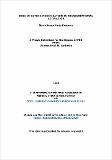Role of SUMO-1 modification in transcriptional activation
Abstract
In unstimulated cells, the transcription factor NF-κB is held in the
cytoplasm in an inactive state by IκB inhibitor proteins. Activation of NF--KB is
mediated by signal induced degradation of IκBα via the ubiquitin proteasome-dependent
pathway. Targeting the proteins for ubiquitin-mediated proteolysis is an
irrevocable decision, and as such, the process needs to be highly specific and tightly
regulated. This task is achieved by conjugation and deconjugation enzymes that act
in a dynamic and coordinated mechanism.
In a yeast two hybrid screen designed to identify proteins involved in IκBα
signalling Ubch9 was found to interact with the N-terminal regulatory region of
IκBα. Although Ubch9 is an enzyme homologous to E2 ubiquitin conjugating
enzymes we have shown that is unable to form a thioester with ubiquitin but it is
capable to form a thioester with the small ubiquitin-like protein SUMO- 1. To fully
characterise the SUMO-1 modification reaction we have purified the proteins and
cloned the genes encoding the SUMO-1 activating enzyme (SAEl/SAE2) and
shown that it is homologous to enzymes involved in the activation of ubiquitin,
Smt3p, the yeast SUMO-1 homologue, and Rublp/Nedd8, another ubiquitin-like
protein. SUMO-1 is conjugated to target proteins by a pathway that is distinct from,
but analogous to, ubiquitin conjugation.
SUMO-1 was efficiently conjugated, both in vivo and in vitro, to IκBα on
lysine 21, which is also utilised for ubiquitin modification. Thus, by blocking
ubiquitination SUMO-1 modification acts antagonistically to generate a pool of
IκBα resistant to proteasome-mediated degradation which consequently inhibits
NF-κB dependent transcription activation.
In view of several lines of similarity between NF-kB and p53, the
involvement of SUMO-1 modification in the metabolism of the tumour supressor
p53 was investigated. We have shown that p53 is modified by SUMO-1 at a single
site, lysine 386 in the C-terminus of p53. Although p53 is regulated by
ubiquitination, SUMO-1 and ubiquitin modification do not compete for the same
lysine in p53. However, overexpression of SUMO-1 activates the transcriptional
activity of wild type p53, but not K386R p53 where the SUMO-1 acceptor site has
been mutated.
A consensus sequence was obtained by comparison of the sequences
surrounding the SUMO-1 acceptor lysine in proteins that have been shown to be
modified by SUMO-1 and revealed a possible recognition site for SUMO-1
conjugation machinery.
Tagging of proteins with SUMO-1 regulates transcriptional activation, either
by interfering with subcellular location or with the ubiquitination pathway. The
pathway may represent a novel target for drug development.
Type
Thesis, PhD Doctor of Philosophy
Collections
Items in the St Andrews Research Repository are protected by copyright, with all rights reserved, unless otherwise indicated.

